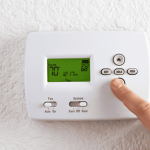
How to Improve Indoor Ventilation in Your Home
At first glance, it may seem like a good idea to keep your home as airtight as possible to keep the heat out and the AC flowing. While it’s true that an airtight home can be energy-efficient, it can be too airtight, preventing something just as valuable: indoor ventilation.
In a well-balanced home, air flows freely in and out without compromising the heating and cooling effects of your home comfort system. But how much air flow is too much, and how can you know the difference? Here’s what you need to know about proper levels of indoor ventilation in your home.
Why Indoor Ventilation Matters
Having proper indoor ventilation is important because it keeps the air clean. When fresh air can circulate, it dilutes pollution that would otherwise build up in an airtight room. Common pollutants include excess moisture, odors, gases, dirt and dust. Allowing plenty of air to move through a room helps to dilute and remove unwanted pollution daily. It can even prevent virus from spreading.
Ventilation is especially important in areas with short-term pollutants that build up quickly. For example, food odors in the kitchen, or strong chemicals from hobbies such as painting or sanding, can become overwhelming. As an added bonus, ventilation can help regulate indoor temperatures because air is moving throughout all areas in the house.
How to Know if Your Home is Well-Ventilated
Now that you know the importance of good indoor ventilation, how can you tell if your home is up to snuff? When a space is not properly ventilated, it’s referred to as inadequate air exchange. This can lead to the build-up of those nasty pollutants. To determine whether your home has inadequate air exchange, look for these signs.
- Odors that persist for more than a few hours, even though the source is no longer emitting the odor. (For example, you cooked fish hours ago but the smell in your kitchen hasn’t gotten any less fishy).
- Excess moisture building up indoors, which can present itself as condensation and mold.
If you see one or both of these signs in your home, it may be time to look at what you can do to boost the circulation of clean air.
How to Improve Ventilation
While heating and cooling systems can bring outdoor air inside to some extent (referred to as mechanical ventilation), this mostly happens in large industrial buildings. For residential homes, you are mostly relying on natural ventilation.
Natural ventilation is exactly what it sounds like. It comes from doors and windows, cracks in the building, and spaces around windows, doors, floor and the ceiling. While you may not like thinking of your home as having openings to the outdoors, it is actually a very good thing. These sources of natural ventilation allow your home to breathe and let unwanted pollution out.
For a little extra ventilation, you can use exhaust fans to spot-treat areas of excess moisture, such as the kitchen and bathroom. It’s also important to make sure your clothes dryer is vented to the outdoors and to check the vent often for buildup.
Bring in the Experts
Proper indoor ventilation is big part of keeping your home fresh, clean and feeling good. Thankfully, the solution can be as simple as opening your windows to optimize air flow. If you’re concerned about the air quality in your home, Barineau Heating and Air Conditioning can help. Our team of home comfort specialists can help you identify issues with air flow, improve efficiency and keep your home feeling like a breath of fresh air all year long. Click here to schedule an appointment today.




